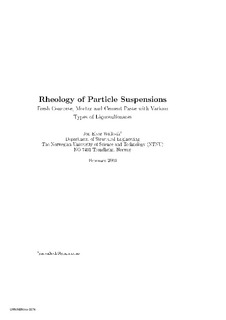Rheology of Particle Suspensions: Fresh Concrete, Mortar and Cement Paste with Various Types of Lignosulfonates
Doctoral thesis
Permanent lenke
http://hdl.handle.net/11250/236410Utgivelsesdato
2003Metadata
Vis full innførselSamlinger
Sammendrag
The major issue concerns how the different lignosulfonate types changes the rheological properties of the cement based material (concrete, mortar and cement paste) as a function of temperature and time. In such terms, it is demonstrated that the high molecular weight lignosulfonates performs far better than the low molecular weight ones. The former type also performs considerable better compared to a naphthalene based polymer.
The above investigation is done with help from the second part of this thesis, which identifies some of the parameters p1, p2,... affecting the shear viscosity η = η ( p1, p2,...) of the cement based material. This is done by investigating the thixotropic behavior of cement paste mixed with either lignosulfonates or naphthalene. The thixotropic behavior is directly related to coagulation, dispersion and re-coagulation of the cement particles. In making the analysis, a modification is applied to the Hattori-Izumi theory, which is a theory about the bookkeeping of the number of reversible coagulated connections between the cement particles. The modification consist, among other things, of include a fading memory to the analysis. That is, the cement paste is allowed to remember its recent past. By a combination of experimental results and numerical simulations, it is demonstrated that such memory term is very important.
An experimental error is present during a viscometric measurement on concrete (a coaxial cylinders viscometer is used). The error is generated by particle migration. Investigating and compensating for this error constitutes the third part of this thesis. Realizing the nature of this error, some corrections are applied. However, with these corrections, one is only extracting the viscometric values of a "fat'' concrete that surrounds the inner cylinder of the viscometer after the particle migration is basically complete, and not of the concrete in the original homogenous state.
